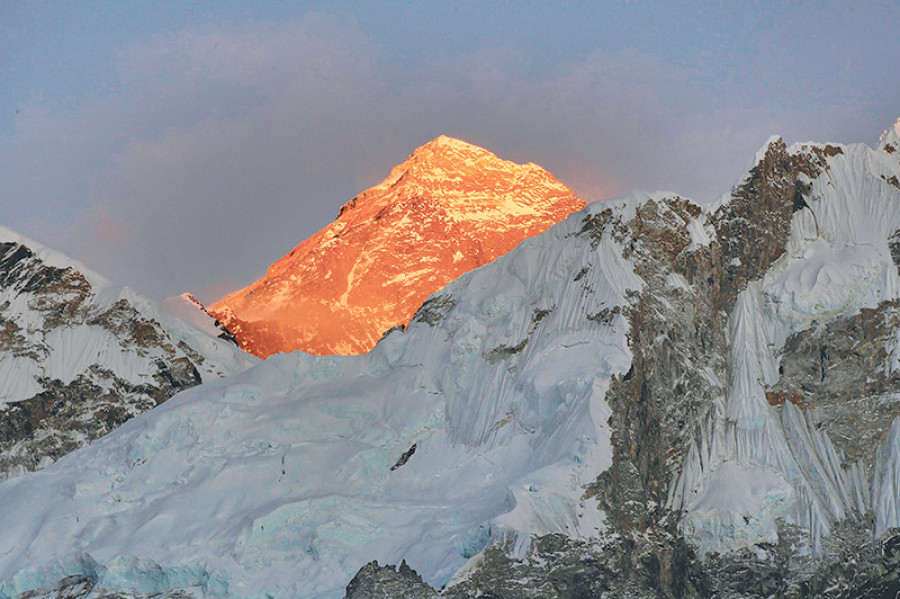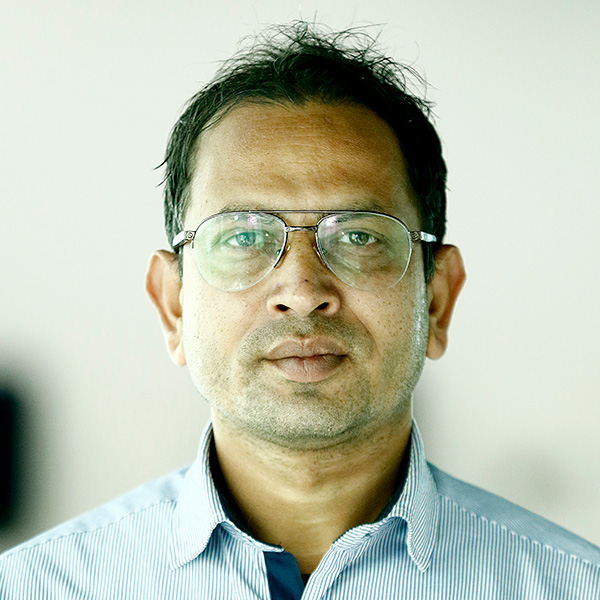Mon, Dec 29, 2025
Miscellaneous
Spring on Everest
Sixty odd years since it was first scaled by Sir Edmund Hillary and Tenzing Norgay Sherpa in 1953, Mount Everest continues to occupy a prominent space in the human imagination.
bookmark 


Sangam Prasain
Published at : June 17, 2017
Updated at : June 17, 2017 16:43
Sixty odd years since it was first scaled by Sir Edmund Hillary and Tenzing Norgay Sherpa in 1953, Mount Everest continues to occupy a prominent space in the human imagination.
As the tallest mountain in the world, its conquest is eulogised as a testament to human endurance and sheer grit, and each year during the spring climbing season, the attention of the world media zeroes in on the Khumbu Region, meticulously reporting the number of accents, tragic fatalities and new records being set.
This climbing season—which ended on May 31—was no different. With a staggering 448 climbers summiting the peak from its South Face in Nepal, the total number of accents inched over the 5,000 mark this year.
There were several new records set—Indian climber Anshu Jamsenpa became the first woman climber to summit Everest twice within five days.
The record was previously held by Chhurim Sherpa, who scaled the peak twice in a season in 2012. Nepali Kami Rita Sherpa joined Appa Sherpa and Phurba Tashi Sherpa by completing a record 21 summit.
But along with the many laudable feats and triumphs, Mount Everest continued to see its share of tragedy, controversy and high drama this year as well.

Into the death zone
The biggest talking point this season came when a daring mission was launched to retrieve the body of an Indian climber, Ravi Kumar, from a 200-meter crevasse at 8,400 metres—an area known as the ‘Death Zone’ for its inhospitable conditions.
Traditionally, those who perish high on the mountain are left entombed in snow because of the obvious dangers to rescuers trying to retrieve bodies from such high altitude.
This complex three-day mission would push the Nepali climbing experts to the far edges of human endurance.
“Our high-altitude climbing experts flew to Camp II at 6,400 metres by helicopter, and then climbed to the Balcony,” said Mingma Sherpa, managing director of Seven Summit Treks, the company that executed the operation.
“It took more than three hours to just pull up Ravi’s body from the crevasse in the ‘death zone’, where the scarcity of oxygen is debilitating.”
The dangerous operation was launched following immense pressure from the Indian government. The mission, which also recovered two other bodies of Indian climbers from the mountain, is expected to exceed $200,000.
Ravi Kumar was one of the six fatalities on Everest this year. On April 30, in another tragic incident, Ueli Steck, a renowned mountain climber dubbed the “The Swiss Machine” for his rapid ascents of some of the world most imposing peaks, died on the slopes of Mt Everest.
He had also obtained the permit to climb Mount Lhotse, the fourth highest mountain in the world at 8,516 metres.
Steck was climbing Mt Nuptse in preparation for an ambitious ascent of Everest through a route that had only once been successfully traversed before.

A week after Steck’s death, an 85-year-old Nepali climber, Min Bahadur Sherchan, who was attempting to become the oldest person to climb Everest passed away at Base Camp.
Sherchan, a former British Gurkha soldier, was trying to reclaim the record from Japan’s Yuichiro Miura, who climbed Everest aged 80 in 2013.
Miura broke Sherchan’s own record set as a 76-year-old in 2008.
But apart from the obvious tragedies, Everest remained clouded in controversy and high drama this year.
The most controversial issue this season came when the news of the collapse of The Hillary Step—a famous rocky outcrop considered the last major obstacle before the final push for the summit—surfaced in the international media.
The reports were based on a Facebook post by Tim Mosedale, a British mountaineer who summited Everest on May 16.
Mosedale wrote on Facebook: “This year, however, I can report that the chunk of rock named ‘The Hillary Step’ is definitely not there anymore…This year and last year a snow ridge formed which we were able to ascend with relative ease.
But in future years, if the ridge doesn’t form, it could be a particularly difficult area to negotiate.” The 12-metre rocky outcrop stands on the mountain’s southeast ridge and was named after Edmund Hillary who was the first to scale it in 1953.
Subsequently, Nepal government issued a statement confirming that the rock face located just below the summit of Everest is intact and covered with snow, refuting reports that it had fallen off as a result of the 2015 earthquake.
“The Tourism Department has collected information following news reports of the destruction of the Hillary Step with the help of icefall doctors who prepare climbing routes on Everest.
They have confirmed that the Hillary Step is still intact and is covered with snow,” the government stated, following a follow-up investigation.
“The misconception may have arisen as a new route to the summit has been created some five metres to the right of the original route through the Hillary Step.”
The government also said, “We are thankful to the Nepal Mountaineering Association (NMA) and icefall doctors for their great work as well as the media which has been consistently reporting about mountaineering events in Nepal.
We would, however, like to request them to please verify such grave news reports with multiple sources before making them public.”
A few days after the Hillary Step ‘hoax’, it was reported that a group of Sherpas had stumbled upon four climbers who had frozen to death in their tents on Camp IV—the highest camp on the mountain.
The government again had to step in to dispel the rumours, announcing that “no casualties have been found and no tents with dead bodies have been discovered” at South Col—a pass between Everest and Lhotse.

Glides and guides
If the rise of social networking and the media’s insatiable appetite for news from Everest has created a sensationalisation effect on the good and bad tidings trickling down from the summit, Nepal government’s lax oversight over expeditions being mounted on Everest also came into sharp focus this year.
Take for instance the incident where an unidentified man who took off from the peak of Mount Ama Dablam (6,812m), at the south of Everest, with the intent of paragliding himself back down.
The man has since disappeared and has not been identified yet. The government officials deployed to monitor unlawful activities in the Khumbu region were mere spectators to the event.
Then, in the first week of May, a South African, Ryan Sean Davy, was nabbed when attempting to climb the peak without first paying an $11,000 permit fee levied on all international climbers.
Once arrested from a cave he was allegedly hiding in, the climber was slapped with a $23,500 fine by the Department of Mountaineering—a fine Davy never ended up paying.
“I came to the Base Camp in hopes of meeting Mt Everest face to face. When I reached the camp, it changed my mind and I became part of an expedition,” said Davy in a conversation with the Post. “The Khumbu Icefall was so fascinating that it didn’t stop me. Obviously, I didn’t have money to pay, but I wanted to be on Everest.”
In the fallout, amid speculation that Davy would have to serve a jail term, interesting things happened.
The Tourism Act 1978 has a provision of slapping a fine double the climbing permit if an illegal accent is made, but there are no clear rules as to the repercussions if the said fine is not paid.
“The issue was complicated because we have a nearly four-decade-old Act that is not clear about further legal action,” says Dinesh Bhattarai, director general of the department.
Given the ambiguity, the government had little options but to release the climber, albeit banning him from any mountaineering activities in Nepal for 10 years.
When the Davy-issue was being debated in the Capital, there was yet another drama transpiring on Everest.
This time a Polish climber Janusz Adam Adamski climbed Everest from the Chinese side but made an illegal descent through Nepal’s South face. Adamski climbed the peak on May 21 from the Chinese route and descended on the Nepali side to complete a rare traverse of Everest, even though he had not obtained necessary permits.
The Pole was also banned from climbing in Nepal for 10 years.
But was Adamski’s traverse of Everest pre-planned?
“He jumped to Nepal’s side, descended down to South Col (7,906m) on Mt Everest and rested there,” said a climbing Sherpa guide, who did not wish to be named.
“He was provided food, oxygen, and shelter there. The next day he descended from the South Col and rested at Base Camp.
Without assistance from Sherpas, his mission to illegally traverse Everest could not be possible. It was a perfect plan, executed to perfection.” Once apprehended, officials at the Department of Mountaineering never interrogated the climber on how he survived without food on Everest for four days, had he made the traverse on his own. Adamski’s answers could have been very interesting.
Wild West
This year, Davy, Adamski and the unidentified paraglider, have brought to the spotlight the roles of liaison officials dispatched by the government to oversee expeditions during climbing season.
Each season, 40-45 officers are sent to the Base Camp as part of an expedition team that monitors illegal activities, although it is no secret that the officials do not remain at the camp all season, if they even get there in the first place.
It has been reported that officials either remain at Lukla or Namchhe Bazaar, or worse go home and wait out the season instead of making the trek to Base Camp. Each official is paid up to Rs 150,000 by the expedition agencies.
“Yes, only few liaison officials reach to the Base Camp,” admits Gyanendra Shrestha, an official at the Tourism Ministry. “It’s very difficult to stay at above 5,000 metre. It’s physically and mentally challenging.”
Even as they spend time as liaison officers, there is little they can do to enforce the law, according to another government official. “Up there, it is a Sherpa’s world.
Speaking against them is like trying to fly against the wind,” he said, “Until and unless the government sets up a temporary security post at the Base Camp or Gorak Shep, illegal activities will continue and likely increase as more and more climber attempt to climb the mountain each year.”
In the 1923, when a reporter asked the legendary British climber George Mallory as to why climb Everest at all, he had famously replied, “Because it is there.” Now, nearly a century later, the mountain continues to draw adventurers wanting to conquer earth’s final vertical frontier.
It seems certain that crowds will be lining up again at Everest in 2018. What remains to be seen is if proper regulations are drafted and enforced before inconvenient controversies become tragedies.
Deaths on Everest
- Nepali mountaineer Min Bahadur Sherchan, 85, died of altitude sickness at Base Camp while waiting for a good weather window to make a summit bid.
- Renowned alpinist Ueli Steck died while climbing Mt Nuptse in preparation for an ambitious ascent of Everest.
- Ravi Kumar of India, 27, collapsed at The Balcony (8,400 metres) before falling into a crevasse.
- Dr Roland Yearwood of the US died near the summit of Mt Everest.
- Vladimir Strba of Slovakia died during a solo climb of the mountain.
- Goth Kubir Rai, a porter, died at the Base Camp .
Editor's Picks
Nepal’s workplaces still fail new mothers
When will Nepali-origin professional footballers in Europe play for Nepal?
‘Like a dream’: Labourer from Dalit community secures full MBBS scholarship
Why Nepal is launching a system to track foreign nationals
Nepal achieves global vaccine target, seven years ahead of schedule
E-PAPER | December 29, 2025
×




 10.12°C Kathmandu
10.12°C Kathmandu








%20(1).jpg&w=300&height=200)

